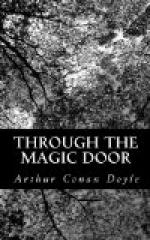But without looking too curiously into his motives, it must be admitted that the work could not have been done more thoroughly. There is something of Herodotus in the Canon’s cheery, chatty, garrulous, take-it-or-leave-it manner. But he has the advantage of the old Greek in accuracy. Considering that he belonged to the same age which gravely accepted the travellers’ tales of Sir John Maundeville, it is, I think, remarkable how careful and accurate the chronicler is. Take, for example, his description of Scotland and the Scotch. Some would give the credit to Jean-le-Bel, but that is another matter. Scotch descriptions are a subject over which a fourteenth-century Hainaulter might fairly be allowed a little scope for his imagination. Yet we can see that the account must on the whole have been very correct. The Galloway nags, the girdle-cakes, the bagpipes—every little detail rings true. Jean-le-Bel was actually present in a Border campaign, and from him Froissart got his material; but he has never attempted to embroider it, and its accuracy, where we can to some extent test it, must predispose us to accept his accounts where they are beyond our confirmation.
But the most interesting portion of old Froissart’s work is that which deals with the knights and the knight-errants of his time, their deeds, their habits, their methods of talking. It is true that he lived himself just a little after the true heyday of chivalry; but he was quite early enough to have met many of the men who had been looked upon as the flower of knighthood of the time. His book was read too, and commented on by these very men (as many of them as could read), and so we may take it that it was no fancy portrait, but a correct picture of these soldiers which is to be found in it. The accounts are always consistent. If you collate the remarks and speeches of the knights (as I have had occasion to do) you will find a remarkable uniformity running through them. We may believe then that this really does represent the kind of men who fought at Crecy and at Poictiers, in the age when both the French and the Scottish kings were prisoners in London, and England reached a pitch of military glory which has perhaps never been equalled in her history.
In one respect these knights differ from anything which we have had presented to us in our historical romances. To turn to the supreme romancer, you will find that Scott’s mediaeval knights were usually muscular athletes in the prime of life: Bois-Guilbert, Front-de-Boeuf, Richard, Ivanhoe, Count Robert—they all were such. But occasionally the most famous of Froissart’s knights were old, crippled and blinded. Chandos, the best lance of his day, must have been over seventy when he lost his life through being charged upon the side on which he had already lost an eye. He was well on to that age when he rode out from the English army and slew the Spanish champion, big Marten Ferrara, upon the morning of Navaretta. Youth and strength




